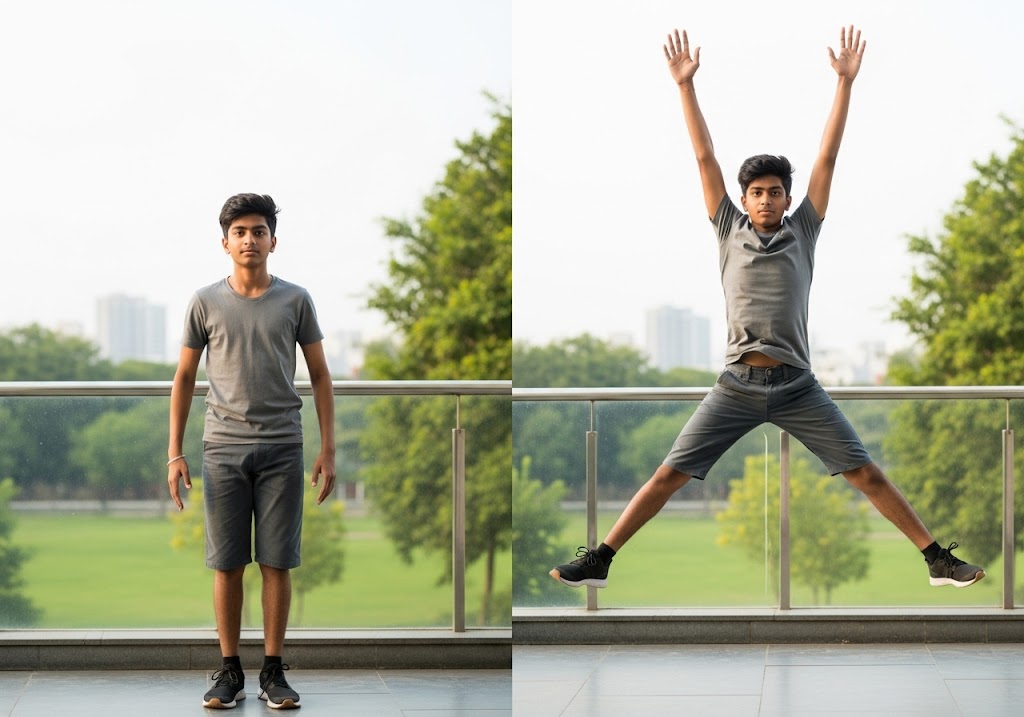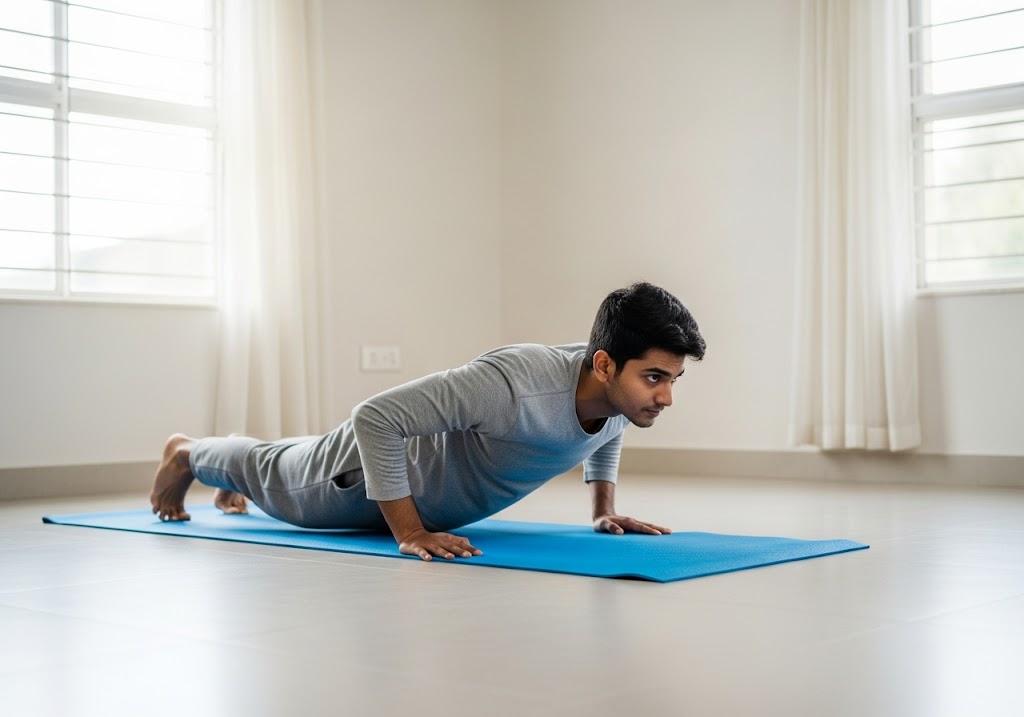Key strategies for jumping jacks for weight loss include: High-intensity intervals, consistent daily practice, progressive volume increases, proper form maintenance, combining with strength training, following structured challenges, tracking calorie burn, and integrating with balanced nutrition for optimal fat loss results.
Want to discover how jumping jacks for weight loss can transform your body while burning serious calories? This simple yet effective cardio exercise combines full-body movement with high-intensity training to create the perfect fat-burning workout. Jumping jacks for weight loss work by elevating your heart rate, engaging multiple muscle groups, and creating the calorie deficit needed for sustainable weight loss results.
Table of Contents
What Are Jumping Jacks?
Jumping jacks are a fundamental bodyweight exercise that involves jumping to a position with legs spread wide and hands overhead, then returning to the starting position with feet together and arms at your sides. This simple movement creates a full-body cardiovascular workout that forms the foundation for effective jumping jacks for weight loss programs.
The exercise originated from military training routines where it was used to improve cardiovascular fitness and coordination among soldiers. Today, jumping jacks for weight loss have become a cornerstone of fitness programs worldwide due to their accessibility, effectiveness, and ability to burn significant calories without requiring any equipment or special training.
The biomechanics of jumping jacks engage your legs, arms, core, and cardiovascular system simultaneously, making them incredibly efficient for weight loss goals. When performed correctly, jumping jacks for weight loss create both cardiovascular conditioning and muscle strengthening benefits that support long-term fitness and health improvements.
For those new to bodyweight training, bodyweight exercises for beginners provides excellent foundation movements that complement jumping jack training.

Jumping Jacks for Weight Loss
Jumping jacks for weight loss represent one of the most effective cardio exercises for burning calories and shedding excess pounds. This high-impact movement elevates heart rate quickly while engaging multiple muscle groups for maximum calorie expenditure and metabolic boost during and after exercise sessions.
| Body Weight (kg) | 10 Minutes | 20 Minutes | 30 Minutes | 60 Minutes | Weekly Goal |
|---|---|---|---|---|---|
| 50-60 kg | 80-95 calories | 160-190 calories | 240-285 calories | 480-570 calories | 2400-2850 calories |
| 60-70 kg | 95-110 calories | 190-220 calories | 285-330 calories | 570-660 calories | 2850-3300 calories |
| 70-80 kg | 110-125 calories | 220-250 calories | 330-375 calories | 660-750 calories | 3300-3750 calories |
| 80-90 kg | 125-140 calories | 250-280 calories | 375-420 calories | 750-840 calories | 3750-4200 calories |
| 90+ kg | 140+ calories | 280+ calories | 420+ calories | 840+ calories | 4200+ calories |
The effectiveness of jumping jacks for weight loss lies in their ability to create significant calorie burn while building cardiovascular endurance and muscle tone. Regular practice leads to improved metabolism, better heart health, and sustainable weight management when combined with proper nutrition and lifestyle habits.
For comprehensive fitness benefits that extend beyond weight loss, jumping jacks exercise benefits provides detailed information about all the advantages of this versatile exercise.
How Many Jumping Jacks to Burn 500 Calories?
Burning 500 calories through jumping jacks for weight loss requires understanding the relationship between exercise intensity, body weight, and duration. Most people need to perform 2,500-4,000 jumping jacks to burn 500 calories, depending on their weight, fitness level, and exercise intensity throughout the session.
A 70kg person typically burns approximately 8-12 calories per minute during moderate-intensity jumping jacks, meaning they would need 42-63 minutes of continuous exercise to burn 500 calories. However, breaking this into intervals makes the workout more manageable and potentially more effective for jumping jacks for weight loss goals.
Explore these resistance band workouts for women designed to sculpt and strengthen using just bands and bodyweight.
500-Calorie Jumping Jack Strategies:
For beginners learning jumping jacks for weight loss, start with shorter intervals and build endurance gradually. Perform 5 sets of 100 jumping jacks with 90-second rest periods, repeating this cycle 5-10 times throughout the day to reach 2,500-5,000 total repetitions for significant calorie burn.
Intermediate practitioners can use circuit training combining jumping jacks with other exercises. Alternate between 2 minutes of jumping jacks and 1 minute of strength exercises like push-ups or squats, continuing for 45-60 minutes to achieve the 500-calorie target while building muscle simultaneously.
Advanced athletes can pursue continuous jumping jack sessions with varying intensities. Perform 10 minutes at moderate pace, 5 minutes at high intensity, and repeat this cycle 3-4 times with minimal rest to maximize calorie burn and improve cardiovascular fitness effectively.
For understanding how jumping jacks compare to other exercises, how many push ups to burn 100 calories provides insight into calorie burning across different bodyweight movements.
Find out how many jumping jacks to burn 500 calories you need-and get tips to make every rep count.

200 Jumping Jacks Calories
Performing 200 jumping jacks for weight loss typically burns 20-40 calories depending on your body weight, exercise intensity, and fitness level. This makes 200 jumping jacks an excellent quick workout option for busy schedules while still contributing meaningfully to daily calorie expenditure and weight loss goals.
The beauty of 200 jumping jacks lies in their accessibility and time efficiency, requiring only 3-5 minutes to complete while providing cardiovascular benefits and calorie burn. For effective jumping jacks for weight loss programming, consider performing 200 jumping jacks 3-5 times throughout the day for cumulative benefits.
200 Jumping Jack Workout Variations:
Morning Energizer: Perform 200 jumping jacks immediately upon waking to boost metabolism, increase alertness, and establish positive momentum for healthy choices throughout the day. This quick routine jumpstarts your jumping jacks for weight loss program effectively.
Workday Breaks: Complete 200 jumping jacks during breaks at work or between daily activities to maintain elevated metabolism and prevent sedentary behavior. These mini-sessions accumulate significant calorie burn while improving energy and focus levels.
Evening Finisher: End your day with 200 jumping jacks to burn extra calories and promote better sleep quality. This routine helps establish consistency in your jumping jacks for weight loss program while providing stress relief after long days.
The cumulative effect of multiple 200 jumping jack sessions creates substantial daily calorie burn while building cardiovascular fitness and supporting sustainable weight loss goals through manageable, sustainable exercise habits.
Try this effective resistance band workout for triceps and boost your arm strength anytime, anywhere.

Benefits of Jumping Jacks for Weight Loss
The benefits of jumping jacks for weight loss extend far beyond simple calorie burning to include improved cardiovascular health, enhanced metabolism, and better overall fitness. This comprehensive exercise provides both immediate calorie expenditure and long-term metabolic improvements that support sustainable weight management goals.
Immediate Benefits:
- High calorie burn rate averaging 8-15 calories per minute
- Full-body muscle engagement including legs, arms, and core
- Improved cardiovascular fitness and heart health
- Enhanced coordination and balance through rhythmic movement
Long-term Benefits:
- Increased metabolic rate lasting hours after exercise completion
- Better insulin sensitivity supporting fat burning
- Improved bone density through weight-bearing impact
- Enhanced mood and energy levels through endorphin release
Weight Loss Specific Benefits:
- Creates calorie deficits essential for fat loss
- Builds lean muscle mass that burns calories at rest
- Improves fat oxidation capacity during exercise
- Supports appetite regulation through hormone optimization
The compound benefits make jumping jacks for weight loss an ideal choice for people seeking efficient, effective exercise that fits into busy lifestyles while delivering measurable results in body composition and overall health.
For additional calorie-burning comparisons, how many calories can you burn doing crunches provides information about abdominal exercise effectiveness.
Jumping Jack Challenge for Weight Loss
A structured jumping jack challenge for weight loss provides motivation, progression, and accountability for achieving sustainable results. These challenges typically span 30 days with gradually increasing volume and intensity to build fitness while maximizing calorie burn and weight loss effectiveness.
30-Day Progressive Challenge Structure:
Week 1 (Days 1-7): Foundation building with 100-300 daily jumping jacks Week 2 (Days 8-14): Volume increase to 300-500 daily jumping jacks
Week 3 (Days 15-21): Intensity focus with 500-750 daily jumping jacks Week 4 (Days 22-30): Peak challenge with 750-1000+ daily jumping jacks
Challenge Success Strategies:
Start each challenge day with proper warm-up including light stretching and gradual movement preparation. This prevents injury while preparing your body for the increased demands of progressive jumping jacks for weight loss training throughout the month-long program. Track your progress using a simple journal or smartphone app, recording daily repetitions, calories burned estimates, and how you feel after each session. This data helps maintain motivation while providing valuable feedback about your jumping jacks for weight loss journey. Break daily totals into manageable chunks throughout the day rather than attempting all repetitions in a single session. This approach maintains exercise quality while making higher volumes achievable and sustainable throughout the challenge period.
For comprehensive workout routines that complement jumping jack challenges, full body calisthenics workout provides complete training programs for total-body fitness.

Tabata Jumping Jack Protocol
Tabata protocol represents one of the most effective high-intensity approaches to jumping jacks for weight loss. This method alternates 20 seconds of maximum-intensity jumping jacks with 10 seconds of complete rest, repeated for 8 rounds to create intense metabolic demand and calorie burn.
- Round Structure: Perform maximum jumping jacks for 20 seconds at highest possible intensity
- Rest Periods: Complete rest for 10 seconds between each high-intensity bout
- Total Duration: Complete workout finished in exactly 4 minutes for time efficiency
- Intensity Focus: Maintain maximum effort throughout all 8 working intervals
- Recovery Planning: Allow 24-48 hours between Tabata sessions for proper adaptation
- Progression Method: Track total jumping jacks completed across all 8 rounds weekly
- Safety Priority: Master standard jumping jack form before attempting Tabata intensity
The Tabata jumping jack protocol maximizes calorie burn and metabolic benefits in minimal time, making it perfect for busy schedules while delivering superior results for jumping jacks for weight loss goals. This method continues burning calories for hours after completion through elevated post-exercise oxygen consumption.
Pyramid Training Protocol
Pyramid training offers an engaging approach to jumping jacks for weight loss through systematically increasing and decreasing repetitions throughout the workout session. This method builds endurance while maintaining interest through constantly changing demands and volume progression patterns.
- Ascending Phase: Start with 10 jumping jacks, increase by 10 each set until reaching peak
- Peak Maintenance: Hold maximum volume for 2-3 sets at your highest achievable repetition count
- Descending Phase: Reduce by 10 jumping jacks each set until returning to starting volume
- Rest Intervals: Take 30-60 seconds rest between each pyramid level for proper recovery
- Weekly Progression: Increase peak volume by 20-50 jumping jacks each week for advancement
- Example Structure: 10-20-30-40-50-40-30-20-10 jumping jacks with rest between each set
- Mental Benefits: Psychological relief during descending phase maintains motivation throughout workout
Pyramid training for jumping jacks for weight loss provides structured progression while preventing monotony that often derails exercise programs. This method builds both physical fitness and mental toughness through systematically challenging and then relieving exercise demands.
Density Training Protocol
Density training maximizes jumping jacks for weight loss effectiveness by completing maximum repetitions within fixed time periods. This approach focuses on gradually increasing work capacity and calorie burn while maintaining consistent exercise duration for busy lifestyle integration.
- Time Blocks: Set fixed periods of 5, 10, or 15 minutes for jumping jack sessions
- Maximum Effort: Perform as many jumping jacks as possible within the time limit
- Rest as Needed: Take breaks when necessary but minimize total rest time
- Progressive Tracking: Record total repetitions completed each session for motivation
- Weekly Goals: Aim to increase total volume by 10-20% each week consistently
- Intensity Variation: Alternate between moderate and high-intensity time blocks
- Recovery Integration: Include easy days with reduced volume for adaptation and recovery
Density training creates competitive elements that maintain engagement while building impressive work capacity for jumping jacks for weight loss programs. This method allows flexible scheduling while ensuring consistent calorie burn and fitness improvement through systematic progression.
For understanding optimal exercise timing and recovery, is it better to do cardio before or after weights provides guidance on exercise sequencing for maximum results.
How Many Jumping Jacks for Weight Loss?
Determining optimal daily volume for jumping jacks for weight loss depends on fitness level, weight loss goals, and available time commitment. Most people achieve meaningful results with 300-1000+ daily jumping jacks spread throughout the day in manageable sessions for sustainable progress.
Daily Volume Recommendations:
Beginners should start with 300-500 jumping jacks daily, spread across 3-5 sessions throughout the day. This volume provides significant calorie burn while allowing gradual fitness adaptation without overwhelming muscles or cardiovascular system during early jumping jacks for weight loss development.
Intermediate practitioners benefit from 500-800 daily jumping jacks using varied intensity levels and training methods. Include high-intensity intervals, steady-state sessions, and recovery periods to maximize calorie burn while building cardiovascular fitness and endurance capacity.
Advanced individuals can pursue 800-1200+ daily jumping jacks through structured programs combining different protocols. Use Tabata, pyramid, and density training methods to create variety while maximizing calorie expenditure and metabolic benefits for accelerated weight loss results.
Weekly Progression Strategy:
- Week 1: Establish baseline with comfortable daily volume Week 2: Increase total volume by 20-30% while maintaining form Week 3: Add intensity variations and advanced protocols
- Week 4: Peak volume with maximum sustainable daily repetitions
The key to successful jumping jacks for weight loss lies in consistent daily practice rather than occasional high-volume sessions. Building sustainable habits creates long-term success while preventing burnout and maintaining motivation throughout your weight loss journey.
For additional calorie-burning exercise comparisons, how many sit ups to burn 1000 calories provides insight into abdominal exercise calorie expenditure.

Proper Form and Technique
Mastering proper form maximizes the effectiveness of jumping jacks for weight loss while preventing injury and ensuring sustainable training. Correct technique involves coordinated arm and leg movement with proper landing mechanics and core engagement throughout each repetition for optimal results.
- Starting Position Setup: Stand with feet together and arms at your sides, maintaining upright posture with engaged core muscles. Keep your head up, shoulders back, and prepare for explosive movement while maintaining control throughout the jumping jacks for weight loss exercise.
- Jump Phase Execution: Jump explosively while simultaneously spreading legs to shoulder-width apart and raising arms overhead. Land softly on the balls of your feet with slight knee bend to absorb impact forces and protect joints during high-volume sessions.
- Return Phase Control: Jump again while bringing feet back together and lowering arms to starting position. Maintain rhythm and control throughout all repetitions, focusing on smooth transitions rather than maximum speed for jumping jacks for weight loss effectiveness.
- Common Form Mistakes: Avoid landing on heels, which creates excessive impact forces and injury risk. Prevent knee cave-in during landing by maintaining proper leg alignment and strong glute activation throughout each repetition.
Proper breathing supports performance and endurance during extended jumping jacks for weight loss sessions. Breathe naturally throughout the exercise rather than holding your breath, which reduces oxygen delivery and limits performance capacity.
For comprehensive warm-up preparation, warm up exercises for beginners provides essential movement preparation techniques.
Creating Your Jumping Jack Workout Plan
Developing an effective workout plan for jumping jacks for weight loss requires balancing intensity, volume, and recovery to maximize results while preventing overuse injuries. Structure your program with progressive overload principles and varied training methods for sustained motivation and continuous improvement.
Weekly Planning Structure:
Monday: High-intensity Tabata protocol (4 minutes + warm-up/cool-down) Tuesday: Moderate volume steady-state (300-500 jumping jacks) Wednesday: Pyramid training with progressive volume Thursday: Active recovery or light movement Friday: Density training with time challenges Weekend: Flexible volume based on energy and motivation
Monthly Progression Cycles:
Week 1: Foundation building with moderate volumes Week 2: Volume increase with maintained intensity Week 3: Peak intensity with advanced protocols
Week 4: Recovery week with reduced volume
Integrate jumping jacks for weight loss with other exercises for comprehensive fitness benefits. Combine with strength training, flexibility work, and other cardio activities to create balanced programs that support overall health and sustainable weight loss goals.
Track progress through multiple metrics including total weekly repetitions, workout duration, perceived exertion, and body measurements. This comprehensive tracking provides motivation while identifying successful strategies for continued jumping jacks for weight loss development.
For understanding different training approaches, calisthenics vs gym explores various fitness methodologies and their benefits for weight loss goals.
Nutrition Support for Jumping Jack Weight Loss
Optimal nutrition supports jumping jacks for weight loss by providing energy for workouts while creating the calorie deficit necessary for fat loss. Strategic meal timing and macronutrient balance enhance exercise performance while maximizing weight loss results from your training efforts.
Pre-Workout Nutrition (1-2 hours before): Consume easily digestible carbohydrates with moderate protein to fuel high-intensity jumping jack sessions. Avoid high-fat or high-fiber foods that may cause digestive discomfort during exercise, especially during intense jumping jacks for weight loss workouts.
Post-Workout Recovery (within 30-60 minutes): Focus on protein and carbohydrate combination to support muscle recovery and glycogen replenishment. This timing optimizes adaptation to your jumping jacks for weight loss training while supporting continued calorie burn through increased metabolic rate.
Daily Nutrition Priorities:
- Maintain slight calorie deficit for sustainable weight loss
- Prioritize protein intake to preserve muscle mass during weight loss
- Stay adequately hydrated before, during, and after exercise sessions
- Include anti-inflammatory foods to support recovery
Meal Timing Strategies: Space meals evenly throughout the day to maintain stable energy levels for consistent jumping jacks for weight loss performance. Avoid large meals immediately before exercise while ensuring adequate fuel for high-intensity training sessions.
For comprehensive nutrition guidance, calisthenics diet chart provides detailed meal planning strategies that support intensive training programs.

Common Mistakes and How to Avoid Them
Avoiding common mistakes maximizes the effectiveness of jumping jacks for weight loss while preventing injuries that could derail your progress. Understanding these pitfalls helps maintain consistent training and optimal results throughout your weight loss journey.
- Volume and Intensity Errors: Starting with excessive volume leads to burnout, injury, and program abandonment. Begin with manageable repetitions and progress gradually to build sustainable habits that support long-term jumping jacks for weight loss success.
- Form Breakdown Issues: Maintaining proper form becomes challenging during high-volume sessions, but poor technique reduces effectiveness and increases injury risk. Focus on quality over quantity, especially when learning proper jumping jacks for weight loss movement patterns.
- Recovery Neglect: Insufficient rest between sessions prevents adaptation and increases overuse injury risk. Schedule recovery days and listen to your body’s signals to maintain consistent progress in your jumping jacks for weight loss program.
- Nutritional Mistakes: Relying solely on exercise without addressing nutrition limits weight loss results. Create appropriate calorie deficits through combined diet and exercise for optimal jumping jacks for weight loss effectiveness.
- Unrealistic Expectations: Expecting immediate dramatic results leads to disappointment and program abandonment. Set realistic goals and celebrate small victories to maintain motivation throughout your jumping jacks for weight loss journey.
For recovery guidance during intensive training, should you exercise with sore muscles provides strategies for training through muscle fatigue safely.
Advanced Jumping Jack Variations
Progressive variations keep jumping jacks for weight loss challenging and engaging as fitness improves. These advanced modifications increase calorie burn, build strength, and prevent adaptation plateaus that can limit continued weight loss progress.
- Plyometric Variations: Jump higher during each repetition to increase power output and calorie burn. These explosive movements build athletic power while maximizing the metabolic demands of jumping jacks for weight loss training sessions.
- Weighted Variations: Add light hand weights or weighted vest to increase resistance and calorie expenditure. Start with 1-2kg additions and progress gradually as strength and endurance improve throughout your jumping jacks for weight loss program.
- Combination Movements: Integrate other exercises like squat jacks, cross-country skiers, or star jumps to create variety while maintaining high intensity. These variations prevent boredom while maximizing calorie burn for jumping jacks for weight loss effectiveness.
- Directional Changes: Perform jumping jacks while moving forward, backward, or side-to-side to challenge coordination and increase difficulty. These variations engage different muscle groups while maintaining the cardiovascular benefits essential for weight loss.
- Tempo Variations: Alternate between slow, controlled movements and explosive, fast-paced repetitions within the same session. This approach challenges different energy systems while maintaining interest in jumping jacks for weight loss training.
For exploring advanced bodyweight movements, calisthenics exercises provides comprehensive exercise progressions for continued fitness development.
Measuring Progress and Results
Tracking progress in jumping jacks for weight loss requires multiple measurement methods to capture improvements in fitness, body composition, and overall health. Comprehensive monitoring maintains motivation while providing valuable feedback for program adjustments and continued success.
- Performance Metrics: Track total daily and weekly repetitions to monitor volume improvements over time. Record workout duration and perceived exertion levels to gauge fitness adaptations and training effectiveness for jumping jacks for weight loss goals.
- Body Composition Changes: Monitor weight, body measurements, and progress photos to document physical changes. Remember that muscle building may mask weight loss on the scale, making measurements and photos crucial for accurate progress assessment.
- Fitness Improvements: Note improvements in endurance, coordination, and recovery time between sessions. These fitness markers often improve before visible body composition changes, providing early motivation for continued jumping jacks for weight loss training.
- Health Indicators: Track resting heart rate, blood pressure, and energy levels as indicators of cardiovascular health improvements. These markers demonstrate the broader health benefits of jumping jacks for weight loss beyond simple weight management.
- Goal Setting: Establish specific, measurable, achievable, relevant, and time-bound (SMART) goals for your jumping jacks for weight loss program. Regular goal review and adjustment maintains focus while celebrating achievements along your journey.
For additional progress tracking comparisons, how many calories does a plank burn provides insight into different exercise calorie expenditures.
Long-term Success Strategies
Sustaining jumping jacks for weight loss requires developing habits, systems, and mindset that support long-term adherence. Success depends more on consistency over months and years than on perfect execution over short periods.
- Habit Formation: Link jumping jacks to existing daily routines like morning coffee or evening TV watching. These environmental cues trigger automatic behavior that supports consistent jumping jacks for weight loss practice without relying on motivation alone.
- Flexible Programming: Develop multiple workout options for different time constraints, energy levels, and circumstances. This flexibility prevents missed sessions while maintaining progress in your jumping jacks for weight loss program regardless of life challenges.
- Social Support: Share your goals with family and friends or join online communities focused on jumping jacks for weight loss. Social accountability and encouragement significantly improve long-term adherence and success rates.
- Continuous Learning: Stay informed about new techniques, variations, and research related to jumping jacks for weight loss. Continuous learning maintains interest while providing new challenges that prevent stagnation and boredom.
- Lifestyle Integration: View jumping jacks for weight loss as part of a healthy lifestyle rather than temporary weight loss intervention. This perspective promotes sustainable habits that support long-term weight management and overall health.
For comprehensive lifestyle support, intermittent fasting plan provides nutrition strategies that complement intensive exercise programs for optimal results.

Recovery and Injury Prevention
Strategic recovery prevents overuse injuries while optimizing adaptations from jumping jacks for weight loss training. Proper recovery practices ensure consistent training ability and continued progress toward weight loss and fitness goals.
- Active Recovery Methods: Include light walking, stretching, or gentle movement on rest days to promote blood flow and muscle recovery. These activities support adaptation while maintaining movement habits essential for jumping jacks for weight loss success.
- Sleep Optimization: Prioritize 7-9 hours of quality sleep nightly to support muscle recovery, hormone regulation, and metabolic health. Adequate sleep enhances weight loss results while providing energy for consistent jumping jacks for weight loss training.
- Stress Management: Implement stress reduction techniques like meditation, deep breathing, or relaxation exercises. Chronic stress interferes with weight loss and recovery, potentially limiting the effectiveness of jumping jacks for weight loss programs.
- Injury Prevention: Wear appropriate footwear, exercise on suitable surfaces, and progress volume gradually to prevent overuse injuries. Listen to your body and modify intensity when experiencing fatigue or discomfort during jumping jacks for weight loss training.
- Recovery Monitoring: Pay attention to sleep quality, energy levels, and motivation as indicators of recovery status. Adjust training intensity and volume based on these signals to maintain consistent progress without overreaching.
Understanding recovery techniques such as what is foam rolling can enhance your training recovery and reduce injury risk during intensive exercise programs.
Conclusion
Jumping jacks for weight loss offer an accessible, effective, and versatile approach to burning calories and achieving sustainable weight loss results. From basic movements to advanced protocols, this fundamental exercise provides scalable challenges that grow with your fitness level while delivering consistent calorie burn and health benefits. Success with jumping jacks for weight loss requires consistent practice, progressive challenge, and integration with proper nutrition for optimal results. Whether performing quick 200-repetition sessions or structured 500-calorie workouts, the key lies in building sustainable habits that support long-term weight management and overall health improvement through regular physical activity.
Want to master the calisthenics handstand and take your skills to the next level? Whether you’re a beginner or pushing advanced skills, ISC – Indian School of Calisthenics offers expert guidance to help you master bodyweight training. Visit us at SRPF Ground, NH8, Goregaon (E), Mumbai – 400065. For class schedules, personalized coaching, or more details, call +91 77159 53218. Train smart, move better, and unlock your back strength with ISC.
Jumping Jacks for Weight Loss – FAQs
How many jumping jacks to burn 500 calories?
Most people need 2,500-4,000 jumping jacks to burn 500 calories, depending on body weight and exercise intensity throughout the session.
Do 200 jumping jacks burn calories effectively?
Yes, 200 jumping jacks burn 20-40 calories and provide excellent cardiovascular benefits in just 3-5 minutes of exercise time.
What are the benefits of jumping jacks for weight loss?
Jumping jacks burn 8-15 calories per minute, engage multiple muscle groups, boost metabolism, and improve cardiovascular fitness for effective weight loss.
How many jumping jacks should I do daily for weight loss?
Beginners should start with 300-500 daily jumping jacks, progressing to 800-1200+ as fitness improves for optimal weight loss results.
Can jumping jack challenges help with weight loss?
Yes, structured 30-day challenges provide motivation, progression, and accountability while building habits that support sustainable weight loss success.
What is the proper form for jumping jacks?
Stand straight, jump while spreading legs and raising arms overhead, then return to starting position with soft landings and controlled movements.
How do Tabata jumping jacks work for weight loss?
Tabata protocol alternates 20 seconds maximum intensity with 10 seconds rest for 8 rounds, maximizing calorie burn and metabolic benefits.
Are jumping jacks effective for belly fat loss?
Yes, jumping jacks create calorie deficits necessary for overall fat loss, including belly fat, when combined with proper nutrition.
Can I do jumping jacks every day for weight loss?
Yes, daily jumping jacks are safe with proper progression and recovery, providing consistent calorie burn for weight loss goals.
How long should I do jumping jacks for weight loss?
Start with 5-10 minute sessions and progress to 20-30 minutes daily, spread throughout the day for optimal weight loss results.


